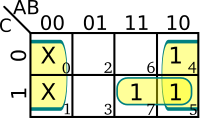(Created page with "{{ba title|incompletely specified function}} An '''Incompletely specified function''' is a Boolean function that only define output values for a subset of its inputs. For...") |
|||
| (6 intermediate revisions by the same user not shown) | |||
| Line 1: | Line 1: | ||
{{ba title|incompletely specified function}} | {{ba title|incompletely specified function}} | ||
| − | An '''Incompletely specified function''' is a [[Boolean function]] that only define output values for a subset of its inputs. | + | An '''Incompletely specified function''' is a [[Boolean function]] that only define output values for a subset of its inputs - i.e. a Boolean function whos output is a [[don't care]] for at least one of its input combinations. Incompletely specified functions often make no guarantees as to the unspecified output whatsoever. |
==Overview== | ==Overview== | ||
| − | In many situations when working with [[combinational circuit]]s, some combinations of inputs | + | {| class="wikitable" style="float: right; width: 140px; text-align: center;" |
| + | ! A !! B !! C !! <math>f</math> | ||
| + | |- | ||
| + | | 0 || 0 || 0 || 1 | ||
| + | |- | ||
| + | | 0 || 0 || 1 || {{X}} | ||
| + | |- | ||
| + | | 0 || 1 || 0 || {{X}} | ||
| + | |- | ||
| + | | 0 || 1 || 1 || 1 | ||
| + | |- | ||
| + | | 1 || 0 || 0 || 1 | ||
| + | |- | ||
| + | | 1 || 0 || 1 || 0 | ||
| + | |- | ||
| + | | 1 || 1 || 0 || 0 | ||
| + | |- | ||
| + | | 1 || 1 || 1 || {{X}} | ||
| + | |} | ||
| + | In many situations when working with [[combinational circuit]]s, some combinations of inputs [[can't happen|should not occur]] under normal working conditions. For circuits with such combinations, those combinations can be treated as either 0 or 1 depending on whichever yields a more [[logic minimization|simplified]] Boolean expression. | ||
| + | |||
| + | Boolean functions with don't care output terms are represented with a <math>d</math>. For example consider the following function. | ||
| + | ::<math>f(A,B,C) = \sum m(0,3,4)+d(1,2,7)</math> | ||
| + | Which can be represented with the following [[truth table]] and [[K-map]]. | ||
| + | |||
| + | ::[[File:kmap unspecified func example.svg|200px]] | ||
| + | |||
| + | Note that depending on the final design of the circuit, the output for <math>f(0,0,1)</math> for example may be either 0 or 1. | ||
| + | |||
| + | == K-map == | ||
| + | [[File:kmap (don't care example).svg|right|200px]] | ||
| + | {{main|karnaugh_map#Don't cares}} | ||
| + | Karnaugh maps are especially suitable for [[logic minimization|minimizing]] logic circuts with [[don't care]] outputs because they directly translate to don't care cells on a k-map. If grouping don't care cells results in larger groups, then more variables may be eliminated resulting in smaller Boolean expressions. | ||
| + | {{clear}} | ||
| + | |||
| + | == Properties == | ||
| + | {{empty section}} | ||
Latest revision as of 20:56, 15 December 2015
An Incompletely specified function is a Boolean function that only define output values for a subset of its inputs - i.e. a Boolean function whos output is a don't care for at least one of its input combinations. Incompletely specified functions often make no guarantees as to the unspecified output whatsoever.
Overview[edit]
| A | B | C | |
|---|---|---|---|
| 0 | 0 | 0 | 1 |
| 0 | 0 | 1 | X |
| 0 | 1 | 0 | X |
| 0 | 1 | 1 | 1 |
| 1 | 0 | 0 | 1 |
| 1 | 0 | 1 | 0 |
| 1 | 1 | 0 | 0 |
| 1 | 1 | 1 | X |
In many situations when working with combinational circuits, some combinations of inputs should not occur under normal working conditions. For circuits with such combinations, those combinations can be treated as either 0 or 1 depending on whichever yields a more simplified Boolean expression.
Boolean functions with don't care output terms are represented with a . For example consider the following function.
Which can be represented with the following truth table and K-map.
Note that depending on the final design of the circuit, the output for for example may be either 0 or 1.
K-map[edit]
- Main article: karnaugh_map#Don't cares
Karnaugh maps are especially suitable for minimizing logic circuts with don't care outputs because they directly translate to don't care cells on a k-map. If grouping don't care cells results in larger groups, then more variables may be eliminated resulting in smaller Boolean expressions.
Properties[edit]
| This section is empty; you can help add the missing info by editing this page. |

